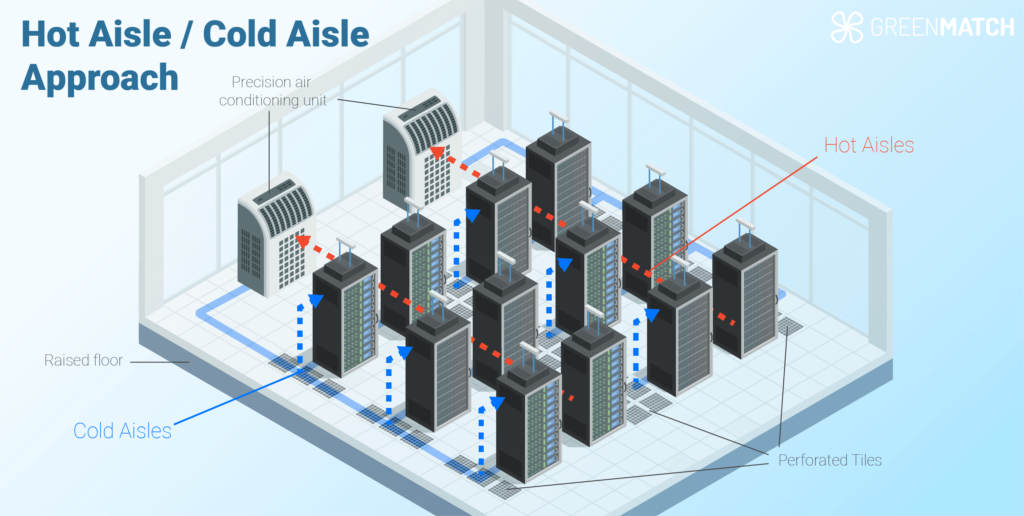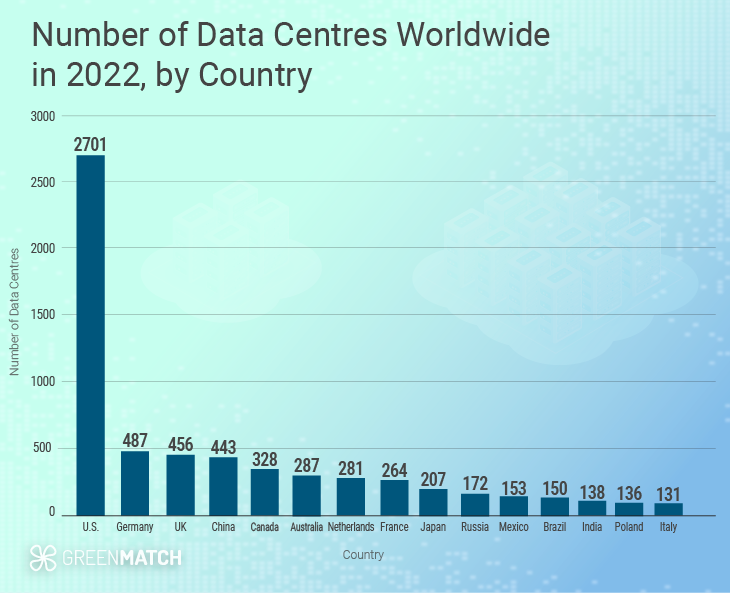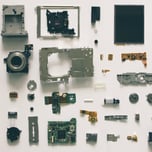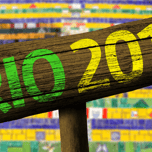- GreenMatch
- Blog
- Data Centre Cooling Solutions: A New Sustainable Era
Data Centre Fuels Concern for Sustainable Data Solutions


Data centres have become a vital part of our infrastructure as the world becomes increasingly digitised. Poorly designed cooling systems can also cause increased carbon emissions. It might be the time that we all paid more attention to the world of data and the vast technologies and software systems that manage it.
For every click of a website, AI tool, email you send or app you use, you're likely feeding into a data centre somewhere! The data centres will generate electronic and toxic waste.
Data centres are large storage areas that house multiple servers and other computing equipment. These servers handle all the data connected to a product, business and almost anything on the internet.
These vast data management sites are crucial to the performance of online products, but they're also what keeps our digital information safe, both in digital and physical form. Unsurprisingly, these servers get hot with all this electronic technology working away day and night!
As more data centres are required for the expanding world of online products, the heating and cooling of these vast servers is paramount. An air source heat pump can significantly enhance the energy efficiency of data cooling centres by transferring heat rather than generating it. Potentially reducing the operational costs and reduced carbon emissions by 50%. Not only does this reduce the chances of devastating fires, but cooling these heat emitters is vital for protecting our environment.
In this article, we'll be looking more closely at data centres, how technology firms implement cooling techniques and discovering if all this heat and cooling impacts our environment and if there is more to be done to keep this valuable resource sustainable.
What is a data centre?
Imagine the sheer vastness of every piece of information and data that feeds into the internet daily. All of that data has to be processed and stored securely somewhere!
That's where data centres come in. These centres can be small-scale (like a simple server cupboard) or large-scale (we're talking multiple warehouses). A server is critical for any business holding data or using online storage.
Like how we store photos, videos or files on our computer or an external storage device, data centres do this on a large scale. However, this amount of technical energy comes with issues, and overheating is a significant concern.
How does a data centre cooling system work?
Keeping the correct temperature for any server ensures good performance and all-around safety. When you house multiple servers together, however, things can heat up quickly, which is when you need a reliable cooling system.
Data centre cooling can be done in several ways, with most systems designed to remove excess heat and keep temperatures at the optimal level. This is usually between 18 - 27 degrees Celsius.
Below are some of the most commonly used cooling systems:
Air cooling
For this method, many data centres will adopt an air conditioning system. It usually works by separating rows of servers into 'hot aisles' and 'cold aisles', often in an alternating pattern. In this setup, the front of the servers would face the cold aisle, and the back of the servers would emit heat into a hot aisle.
This technique works because it allows the cool air to circulate whilst the hot air can be extracted or conditioned via vents. In this scenario, the cold air can be distributed via underground ducts. Overall, this method leads to more consistent temperate levels throughout.
Other air cooling systems that use more traditional air conditioning equipment or specialised PAC units (Precision Air Conditioning) designed for data centres exist. These offer precise control over temperature and humidity levels.

Liquid cooling
An alternative method is to use a liquid coolant to extract heat from the servers and other equipment. This can be done in several ways, either through immersion or direct cooling. This system is a relatively new way of cooling, but it can be very cost-effective as it can be targeted to specific pieces of equipment, and liquid is very efficient at absorbing heat.
Immersion cooling is when whole devices are submerged in a specialist fluid. However, direct-to-chip cooling is when tubes of nonflammable fluid are directed to the hottest part of a device (such as a processing chip or motherboard). In both scenarios, once the liquid has absorbed the heat, it turns into a vapour, carrying the heat away from the device.

Evaporative cooling
This method of cooling uses water evaporation as a way to decrease air temperature. This is something that happens naturally as the water heats and evaporates. Sometimes called swamp cooling, hot air is drawn from the data centre and passed through an 'evaporative media'.
This piece of equipment holds and absorbs water, so as the hot air passes through it, it evaporates, causing the air to cool down. This cool air is then circulated through the data centre. This method is highly efficient but unsuitable for some data centres, as it can cause humidity levels to increase.
Other methods
Some additional measures might also help with the cooling process. For example, using perforated tiles and raising the floors allows airflow beneath the equipment. They may also use containment systems, which implement barriers to isolate hot and cold areas.
Problems associated with data centres
We know that data centres are vital, but currently, they present several problems. The most concerning issues are climate change, environmental impact, and the significant amount of natural resources required to run and cool them. Below is a look at the most concerning issues:
Water Usage
Data centres use vast amounts of water for cooling. It can be used to absorb heat through methods like evaporation or immersion. The water needed can be significant depending on the system and heat generated.
It is estimated that up to 5 million gallons (approximately 20 million litres) of water is used daily in data centre cooling. By using water in such quantities, data centres are contributing to water shortages and depletion of resources, particularly in countries where water scarcity and drought are prevalent.
The World Health Organisation (WHO) has predicted that 'by 2025, half of the world's population will live in water-stressed areas'. As concerns grow over this valuable resource, data centres must take action to reduce their impact on wildlife, the environment and local communities.
Energy Consumption
One of the primary issues associated with data centres is the energy required to power and cool the equipment. Cooling systems can be responsible for up to 40% of the total energy consumption of a data centre. Additionally, integrating solar power with air-source heat pumps can decrease electricity bills and reliance on the grid while providing a sustainable and eco-friendly cooling solution for data centres.
Data centres are, by nature, power-hungry facilities. However, a large portion of the energy they use is for cooling. Using equipment such as air conditioning, fans, or monitoring tools produces high energy use.
The International Energy Agency (IEA) reported that in 2022, data centres accounted for 'approximately 1-1.3% of global electricity demand'. These centres are among the most consuming electric power technologies. They contribute to increased carbon emissions and climate change when sourced from fossil fuels such as coal or gas.
Further concerns arise from using highly inefficient cooling systems, which consume more energy than needed. These systems have an even more significant environmental impact if poorly designed for optimal energy use.
The Impact of AI Technology
Artificial Intelligence (AI) has become an increasingly common tool for businesses and individuals in recent years. AI applications are potent programs that use continual machine learning and complex algorithms. This leads to an intensive use of power for these tools to work.
The rise in AI tools and accessibility has resulted in a need for more data centres. This has led to further problems with the level of resources and energy that these centres need to use.
Due to the complex processes these programmes need to run and the ongoing 'training' they require, the equipment that drives them generates large amounts of heat. This has led to concerns about how AI data centres will tackle the cooling of these systems whilst managing the strain on water supplies.
Areas with the most data centres
Data centres are used worldwide, with numbers changing yearly as more are required. Recent data from 2022, however, shows us that the United States, Germany and the UK were the top 3 countries with the most data centres.
As per the chart below, the US was recorded as having 2,701 data centres. The United Kingdom, in comparison, has 456. Given the difference in land mass and population, we might expect to see a difference in totals between these countries. However, we can also see, through business trends, why these countries have the most data centres.
The UK is home to one of the world's largest financial and services sectors. Data power is needed in both industries, and vast, secure technologies are needed to protect them. As a large country, the US tops many sectors, from production to transport and technology. Every industry closely relies on data handling, making these high data centre figures much more understandable when considering the large economies of these countries.
By 2022, the number of data centres had grown significantly, highlighting the need to reduce their carbon footprint. Below is the number of data across the top 15 countries.

Another exciting thing we see here is that whilst China is recognised as the country with the highest carbon footprint, it has significantly fewer data centres than the US by more than half. This could be due to differences in how each country is fuelling their operations or whether the United States use more environmentally positive methods.
Considering the US has such a large quantity of centres, regardless of the current energy methods used to power them, it will be critical to global climate efforts that data centres are run sustainably in the future.
While sources may differ slightly, global data centres are vast. They are rapidly evolving to meet our digital world's growing demands.
As of December 2023, there were about 10,978 data centres worldwide. This figure shows a big increase from previous years. It reflects the growing demand for data storage and processing.

It shows there were 5,381 data centres in the U.S. This is the highest total for any country. This indicates that the U.S. remains dominant in the data centre market.
Hyperscale providers had 992 large data centres at 2023's end. They surpassed 1,000 in early 2024. This trend shows the fast growth of major cloud and tech companies in the data centre space.
Can data centre cooling be sustainable?
Data centre cooling is a big business. To appreciate the scale of cooling operations, we've looked at the value of the cooling market. According to a report by NMSC, globally, the cooling market was valued at £8.17 billion in 2019. The forecast for 2030 is closer to £26.5 billion, showing just how vast the demand is for cooling technology.

Cooling is essential for maintaining data centres. However, many of these centres rely on non-renewable energy sources. This energy is primarily sourced from fossil fuels (coal, natural gas and oil), notably impacting the environment. Here are some effects of using non-renewable energy:
-
Greenhouse gas emissions:
As fossil fuels are burned to produce energy, they release harmful gases into the atmosphere, such as carbon dioxide (CO2) and methane (CH4). This contributes to 2% of the total global greenhouse gas emissions. These gases directly contribute to global warming and climate change.
-
Air pollution:
Fossil-fuelled power also emits pollutants such as sulphur dioxide (SO2), nitrogen oxides (NOx), and particulate matter. Air pollution from these substances can adversely affect human health and ecosystems.
-
Resource depletion:
Non-renewable energy sources are finite and will eventually run out. Continuing to rely on them for data centre cooling depletes these resources and raises concerns about future energy availability.
-
Environmental damage:
The extraction of fossil fuels leads to environmental damage, including the destruction of habitats and ecosystems and air and water pollution.
In some cases, cooling systems use up to 40% of the total energy a data centre needs. If these centres continue to run on non-renewable energy, the global impact will be widespread and irreversible.
Similarly, solar-powered cooling systems can offer substantial cost savings and environmental benefits by utilizing renewable energy to refrigerate necessities. This will create a sustainable and cost-effective solution for cooling applications.
In addition, many current cooling systems are not designed to be energy efficient, which, if coupled with poor monitoring and cooling practices, can lead to significant, ongoing energy waste. Data centres produce over two million tons of electronic waste yearly, about 4% of humanity's e-waste. Electronic waste, also known as e-waste, is toxic and non-biodegradable, and it accumulates in the environment.
There is, however, some hope on the horizon. More alternative solutions are coming for data centres to consider prioritising renewable, clean energy. In addition, some of the world's largest tech companies, such as Google, Microsoft, Meta and Amazon, are making pledges to ensure their data centres become 'water positive' by 2030. The aim is to replace more water than they use during data cooling and refocus their efforts to mitigate their climate impact.
Eco-conscious solutions
As we've seen, keeping data centres cool is a significant sustainability challenge, but new methods are being developed to help counter this issue. Here are some of the ways the data centre industry is finding eco-friendly solutions:
1. Water Reduction
The issue of water waste can be tackled in several ways. By using more efficient cooling systems, water use may be cut down. An alternative is using recycled or reclaimed water instead of freshly sourced. This can make a real difference, as it eliminates the need to take water from habitats or sources that most need it.
More research must be done to evaluate the best possible use of water in data centres, particularly around water reuse and ensuring data centres use their resources most effectively.
2. Energy efficiency improvements
Data centres can reduce their impact on the environment by ensuring their cooling technologies are energy efficient. This can include using new technologies, such as wind or solar-powered equipment, to encourage energy saving.
3. AI data centres
We've seen that AI can cause a significant drain on energy resources in data centres, but some techniques can help to prevent this.
AI needs regular 'training' time to programme new information, etc., which can use large volumes of energy. Some researchers have found, however, that if their AI data centres run on energy from photovoltaic panels, they can operate AI updates using stored solar energy. This means the updates can be done at any time and sustainably.
Liquid cooling is a more efficient method for cooling AI-generated heat levels. If a 'direct-to-chip' liquid cooling system, or even free cooling, can be implemented for AI, it would significantly reduce water use.
4. Free cooling
Data centres in cooler climates can use free cooling methods. Free cooling uses outside air to cool the data centre without mechanical systems. When the outside air is more relaxed than the desired internal temperature, it can be used directly to cool the facility, reducing overall energy consumption.
5. Renewable energy
Many data centres are shifting towards renewable energy sources, such as solar, wind, or hydroelectric power, to offset their carbon footprint. Data centres can make cooling operations more sustainable by relying on renewable energy.
6. Energy management systems
Advanced monitoring tools and energy management systems help data centres optimise cooling operations by adjusting cooling levels based on heat loads and demand. This minimises overcooling and ensures resources are used more efficiently.
7. Heat reuse
Some innovative data centres are exploring the concept of a heat recovery system, where excess heat generated by the servers is captured and redirected for other purposes, such as heating nearby buildings or generating electricity, to reduce overall waste.
8. Government Policies
In some countries, the impact of data centres is an important part of Government policies to tackle climate change. In the UK, for example, data centre practices are expected to be a significant part of the country's net-zero ambitions for 2050.
One of the ways the Government is looking to support decarbonisation efforts is by finding ways to repurpose waste heat and use it in homes and businesses. This could be an excellent opportunity to utilise data centre heat for a positive purpose.
'The Climate Neutral Data Centre Pact' also exists, joined by over 100 cloud and data centre operators throughout Europe. It is a pledge by the sector that data centres will become climate-neutral by 2030. It also requires that these centres be powered by 100% renewable energy.
Energy-efficient system
Data centre cooling systems ensure the efficient and reliable operation of nearly all the online technology we use. As data centres grow, addressing the environmental concerns associated with their cooling operations becomes increasingly crucial.
While cooling technology has improved over the years, data centres consume substantial energy, leading to higher carbon emissions and environmental impact. However, the industry has committed to adopting sustainable initiatives to mitigate these effects.
Solutions to these challenges include opting for energy-efficient systems, renewable energy sources and practising optimised cooling management. Through these efforts, more energy and resources can be saved.
Technology advancements can potentially reduce the environmental impact of data centre cooling, allowing for greener operations. Ultimately, achieving sustainability in data centres requires further research and development. As the world of online technology continues to grow, now is the time for the data centre industry to progress towards a more sustainable future.

Becky is an experienced SEO content writer specialising in sustainability and renewable trends. Her background in broadcast journalism inspires reliable content to help readers live more sustainably every day.
We strive to connect our customers with the right product and supplier. Would you like to be part of GreenMatch?





